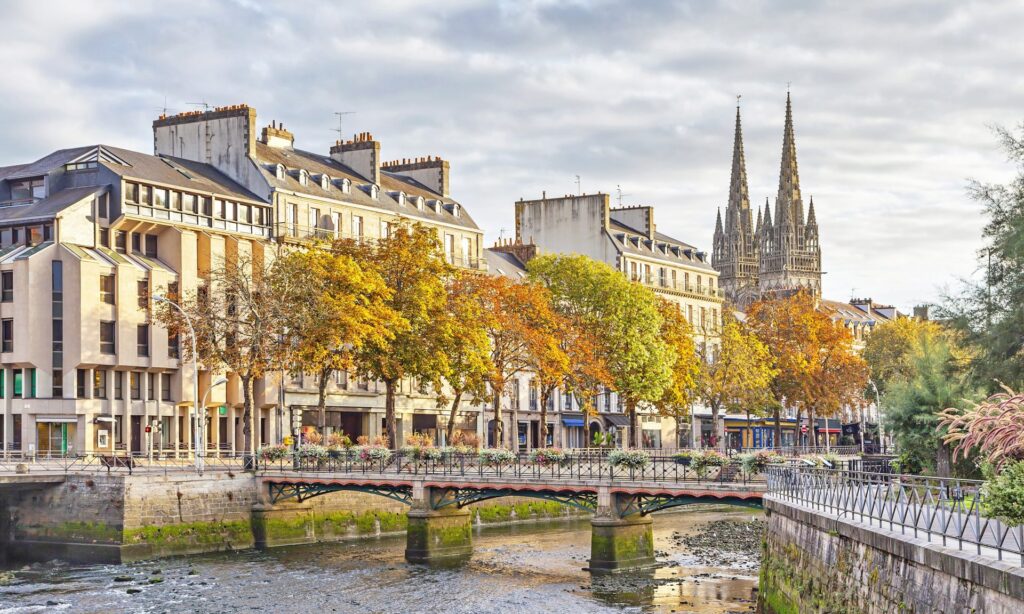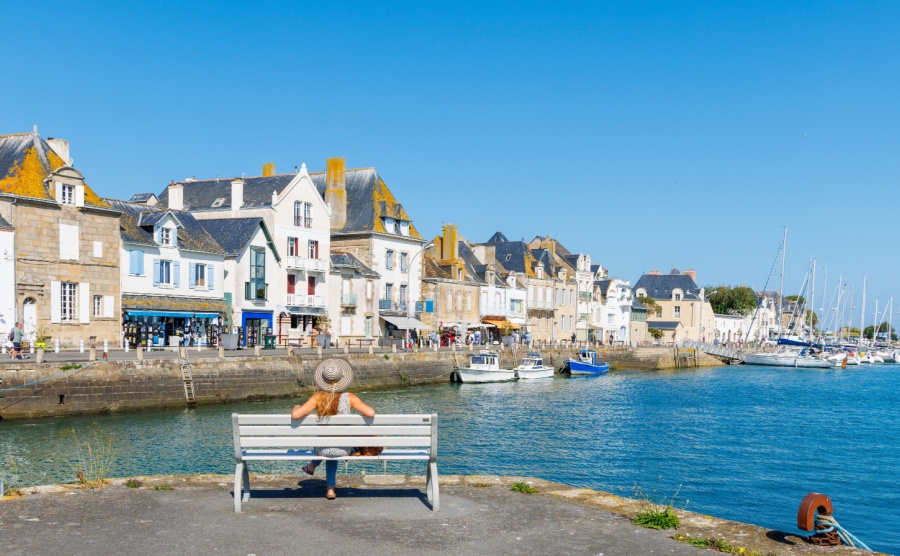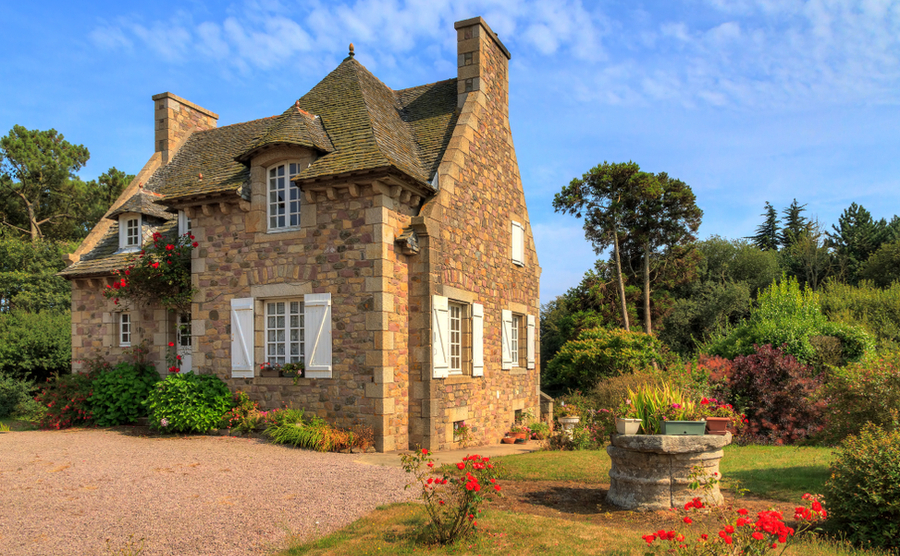Buying property in Brittany
Bretagne, or Brittany, is a region in the top northwest corner of France.
It’s known for its wild coast, Celtic heritage, surfing, galettes and pink onions! It has long been a favourite among British and Irish buyers, being just a short flight or quite long ferry ride away.
During and just after the Covid-19 pandemic Brittany, like Cornwall, attracted buyers from the city now able to work from home by the sea. It’s well connected with Paris and other regions by high-speed TGV trains and a network of motorways. Many have since moved back, yet that appeal remains.
It looks a bit like Cornwall too, with rocky headlands and huge, glorious expanses of sandy beach, yet inland is all small fields, cottages and villages.
However, in size, Brittany is closer to the whole south-west of England. At 27,000km2 it’s bigger than Wales or Massachusetts. It is home to four departments: Finistère, Côtes-d’Armor, Ille-et-Vilaine, and Morbihan.

The bridge over river Odet in Quimper – ancient capital of Cornouaille, Brittany’s most traditional region.
Why buy a home in Brittany?
You can live well in Brittany. The region is famous for its unique culinary traditions, including crepes (known here as galettes), cider and seafood, making it a gastronomic delight. Local festivals often celebrate this heritage, offering a chance to connect with the community and enjoy local produce.
If you head out on a viewing trip, Brittany is just under 300 kilometres west to east and the two cities of Rennes and Brest are at either end. Between the two and along the region’s 1,500km coast, you’ll find hundreds of wonderful communities to choose from. Either way, if it’s a coastal home in Brittany you’re after, you’re spoilt for choice. Even inland, you’re never more than an hour’s drive from the sea.
Port cities in Brittany are often popular with overseas buyers. Brest is a major naval port, but historic coastal towns like Roscoff, Lorient and Quiberon are also popular.
Summers, like anywhere these days, often have temperatures well into the 30°Cs. However, it is certainly cooler than the south of France, more used to sea mists and with the Atlantic so much cooler and wilder than the Mediterranean. You can surf in Brittany in charming resorts such as Locquirec.
There are also wild places, including the Brocéliande forest that some say was the real inspiration for the tales of King Arthur, and wild moors and mountains such as Monts d’Arrée.
But Brittany’s greatest appeal is certainly its seaside.

The seaside village of Croisic, Brittany
What can you buy for your money in Brittany?
Average property prices in Brittany as of 2024 are around €2,700 per square metre. However, it being a vast area there is plenty of variation. You might be paying less than €1,500m2 inland but four times that in a popular city like Dinard.
You can buy an inland cottage in need of significant TLC for less than €50,000, but for a house with a garden, maybe a sea view, close to a town, a budget of €500,000 would be more realistic.
According to recent Notaires data, the average property price for older homes in Brest, on the northwest coast is €242,200 and the median price per square metre for older apartments in the capital, Rennes, is €3,940.
The capital of Brittany, Rennes, is a university city buzzing with life. There are pretty, half-timbered houses and the city boasts both historical charm and modern appeal, making it a captivating place to live.
Along the rugged coastline, you’ll find a string of charming fishing villages and historic towns. Saint-Malo is a favourite for tourists and was made famous recently by the novel All the Light We Cannot See.
If you’re drawn to seaside living, the elegant towns of Dinard or Roscoff could be just right, but again they do get somewhat overrun by tourists in summer. Lannion, Morlaix, and Plouguerneau are just three of dozens of lovely towns, all with a market and lively all year round.
Inland, the region offers peaceful rural landscapes dotted with quaint towns like Pont-Aven, known for its art history, and the mythical forest of Brocéliande.
In terms of property prices, the market is rather dynamic. It’s more common than not to own your own home in Brittany and there are a range of properties for each price point. Typically, homes closer to the coast cost more, but the region is largely affordable, compared to neighbouring regions.

A traditional country house in Brittany, France,
Steps to buying property in Brittany
- Define your criteria: Determine what you’re looking for in terms of property type, location, budget and must-have features.
- Research: Use online resources, visit local real estate agencies and explore the area to find properties that match your criteria. Book your place at the Your Overseas Home Virtual Event.
- Speak to a currency expert: Moving exchange rates is a risk in international property purchases, so discuss managing that risk with a forward contract that fixes your exchange rate.
- Legal considerations: Familiarise yourself with the French property buying process, including the role of the notaire, who handles the legal aspects of the sale. Contact an independent lawyer at this stage.
- Financing: Investigate mortgage options if required. French banks offer loans to non-residents, but it’s advisable to compare rates and terms.
- Book your viewing/scouting trip: Download the guide, contact estate agents and book your tickets.
- Making an offer: Once you find a property you like, you can make an offer. If accepted, you’ll sign a preliminary contract (compromis de vente or a promesse de vente) and pay a deposit.
- Completion: The final sale is completed when the acte de vente is signed at the notaire’s office, and the balance of the purchase price is paid.
Costs of buying property in Brittany
When buying property in Brittany or wider France, the buyer is responsible for notaire fees, which average 7-8% of the property price (or 2-3% for new homes) and will have to also consider estate agent fees (although often included in the property price) and homeowner taxes.
You might also like:

